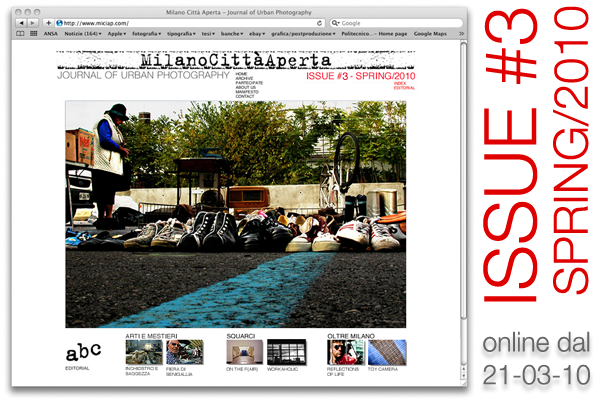EDITORIAL
The fil rouge of the 14 photo reportages selected for this issue has evolved from a research that, rather than focus on the most immediate point of view, prefers the limits, dynamic places sensitive to changes. These extreme places are in fact the first to undergo the transformations and tell everything that happens inside of them through the consequences that show.
Per me si va ne la città dolente... (Through me the way into the grieving city...) The beginning of the third canto of Dante's Divine Comedy could be an effective caption for our first section, that features two projects on the border areas of Milan. A post-apocalyptic scenario, of degradation and ruin, opens the 14th number of MilanoCittàAperta. A traveler who attempted entering the city in a different way would be facing landscapes devastated by a consuming and silent trench warfare between the agricultural land and the grey violence of the urban city. A clash that is far from the gaze of most people, at the expense of the most defenseless and exposed to a degrading exploitation. Have we really lost the ability to take charge of our territory?
Dinanzi a me non fuor cose create / se non etterne, e io etterno duro. (Before me were no things created / except eternal ones, and I endure eternal.) The second section "glimpses" proposes two alternative points of view of these boundary lines. The images seem to suggest that there is a possibility of a look, able to reconfigure reality. The bypasses and the view of the Lambro river become unreal landscapes, acquiring an unexpected meaning. This reflection is an attempt to dispute the words engraved on our imaginary gate of hell: there is nothing eternal and immutable in the management of our land and in the look we have on our city.
Lasciate ogne speranza voi ch'intrate. (Abandon every hope, you who enter.) Our look is now moving in the direction of humanity, to the inhabitants of this damned city that hopes a redemption. Is there no possibility of a life in this urban hell? The third section is again in controversy with the verses of Dante and shows two photographic works on the border areas of Milan, Barona and Via Padova, where, in spite of the threats of the gate of hell, life vibrates and men face their daily battles and are far from abandoning their hopes. These people are the starting point for imagining new ways of relating with the territory.
Milano, now locked between different boundary lines, has to get rid of its limits by gaining hope and learning to be open to new visions.
Ulysses, one who knew well the passing of limits, suggested: Fatti non foste a viver come bruti, / ma per seguir virtute e canoscenza. (You were not born to live like animals, / but to pursue virtue and possess knowledge.)
Good vision.


